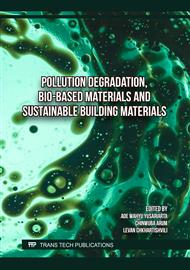[1]
Ngo, T.-D., (2020) Fiber Composites, in Introduction to Composite Materials
Google Scholar
[2]
Rajak, D.K., et al., Recent Progress of Reinforcement Materials: A Comprehensive Overview of Composite Materials, Journal of Materials Research and Technology, (2019) 6354-6374.
DOI: 10.1016/j.jmrt.2019.09.068
Google Scholar
[3]
Srivastava, J.P. and P. Kumar, (2022) Introduction to Glass Fiber-Based Composites and Structures, in Natural and Synthetic Fiber Reinforced Composites: Synthesis, Properties and Applications
DOI: 10.1002/9783527832996.ch1
Google Scholar
[4]
Wambua, P., J. Ivens, and I. Verpoest, Natural Fibres: Can They Replace Glass in Fibre Reinforced Plastics?, Composites Science and Technology, (2003) 1259-1264.
DOI: 10.1016/s0266-3538(03)00096-4
Google Scholar
[5]
Keya, K.N., et al., Natural Fiber Reinforced Polymer Composites: History, Types, Advantages, and Applications, Materials Engineering Research, (2019) 69-87.
Google Scholar
[6]
Khalili, P., et al., Ramie Fabric Elium® Composites with Flame Retardant Coating: Flammability, Smoke, Viscoelastic and Mechanical Properties, Composites Part A: Applied Science and Manufacturing, (2020).
DOI: 10.1016/j.compositesa.2020.105986
Google Scholar
[7]
Venka teshwaran, N., A. Elaya Perumal, and R.H. Arwin Raj, Mechanical and Dynamic Mechanical Analysis of Woven Banana/Epoxy Composite, Journal of Polymers and the Environment, (2012) 565-572.
DOI: 10.1007/s10924-011-0410-5
Google Scholar
[8]
Sonar, T., et al., Natural Fiber Reinforced Polymer Composite Material-A Review, IOSR Journal of Mechanical and Civil Engineering (IOSR-JMCE), (2015).
Google Scholar
[9]
Kan, Z., et al., Investigation on The reactive Processing of Textile-Ramie Fiber Reinforced Anionic Polyamide-6 Composites, Composites Science and Technology, (2015) 188-195.
DOI: 10.1016/j.compscitech.2015.01.023
Google Scholar
[10]
Shi, H., et al., Manufacture and Performance of Textile-ramie Fiber Reinforced Anionic Polyamide 6 Composites, Fibers and Polymers, (2019) 1705-1715.
DOI: 10.1007/s12221-019-8968-y
Google Scholar
[11]
Ben Hamou, K., et al., Synergistic Association of Wood /Hemp Fibers Reinforcements on Mechanical, Physical and Thermal Properties of Polypropylene- Based Hybrid Composites, Industrial Crops and Products, (2023).
DOI: 10.1016/j.indcrop.2022.116052
Google Scholar
[12]
Khuntia, T. and S. Biswas, Mechanical, Viscoelastic, and Flammability Properties of Polymer Composites Reinforced with Novel Sirisha Bark Filler, Journal of Industrial Textiles, (2022) 5887S-5909S.
DOI: 10.1177/15280837221094220
Google Scholar
[13]
Lee, Y.A., et al., Hygroscopic Ramie Fabrics for Recovering Highly Viscous Low Sulfur Fuel Oil, Environmental Pollution, (2022).
DOI: 10.1016/j.envpol.2022.119668
Google Scholar
[14]
Suriaman, I., et al., The Effect of Alakli Treatment on Improving The Mechanical Properties of Ramie (Boehmeria Nivea), Sugar Palm (Arenga Pinnata), and Coir (Cocos Nucifera) Fibers, ASEAN Engineering Journal, (2021) 177-189.
DOI: 10.11113/aej.v11.17053
Google Scholar
[15]
He, L.P., Y. Tian, and L.L. Wang, Study on Ramie Fiber Reinforced Polypropylene Composites (RF-PP) and its Mechanical Properties, Advanced Materials Research, (2008) 313-316.
DOI: 10.4028/www.scientific.net/amr.41-42.313
Google Scholar
[16]
Sun, Y., et al., Effect of Alkali and Silane Treatments on Properties of Green Composites Based on Ramie Fibers and Cellulose Acetate Resin, Bio Resources, (2022) 2390-2402.
DOI: 10.15376/biores.17.2.2390-2402
Google Scholar
[17]
Lu, J.-J., et al., Enhanced Mechanical Properties of Ramie Fabric/Epoxy Composite Laminates by Silicon Polymer, Industrial Crops and Products, (2023).
DOI: 10.1016/j.indcrop.2023.116778
Google Scholar
[18]
Moudood, A., et al., Flax Fiber and Its Composites: An Overview of Water and Moisture Absorption Impact on Their Performance, Journal of Reinforced Plastics and Composites, (2018) 323-339.
DOI: 10.1177/0731684418818893
Google Scholar
[19]
Mwaikambo, L.Y. and M.P. Ansell, The Effect of Chemical Treatment on The Properties of Hemp, Sisal, Jute and Kapok for Composite Reinforcement, Die Angewandte Makromolekulare Chemie, (1999) 108-116.
DOI: 10.1002/(sici)1522-9505(19991201)272:1<108::aid-apmc108>3.3.co;2-0
Google Scholar
[20]
Mwaikambo, L.Y. and M.P. Ansell, Chemical Modification of Hemp, Sisal, Jute, and Kapok Fibers by Alkalization, Journal of Applied Polymer Science, (2002) 2222-2234.
DOI: 10.1002/app.10460
Google Scholar
[21]
Zulkipli, N.A., et al., Effect of Chemical Treatment on Mechanical and Morphological Properties of Sugarcane Bagasse Reinforced Unsaturated Polyester Composite, Key Engineering Materials, (2022) 26-32.
DOI: 10.4028/p-v94mv5
Google Scholar


